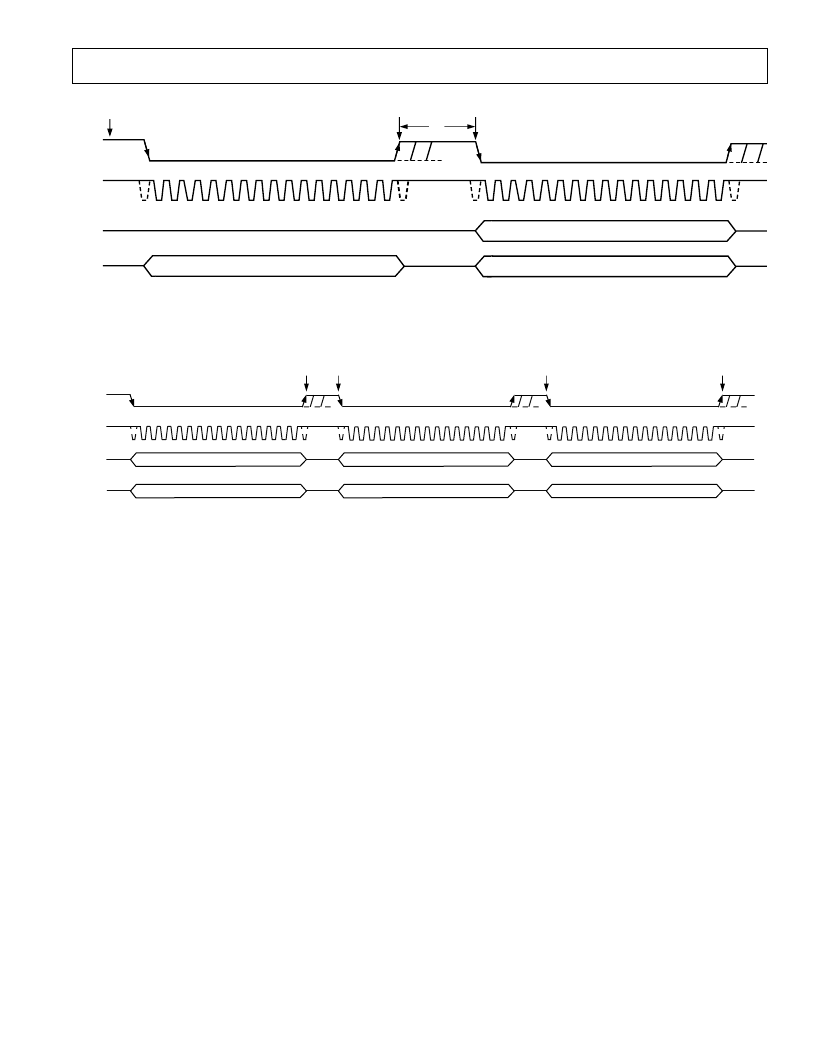- 您現在的位置:買賣IC網 > PDF目錄373926 > AD7923 (Analog Devices, Inc.) SHROUDED HEADER 60 PIN STRAIGHT PDF資料下載
參數資料
| 型號: | AD7923 |
| 廠商: | Analog Devices, Inc. |
| 元件分類: | ADC |
| 英文描述: | SHROUDED HEADER 60 PIN STRAIGHT |
| 中文描述: | 4通道,200 kSPS的,12位序列ADC的16引腳TSSOP |
| 文件頁數: | 15/20頁 |
| 文件大小: | 430K |
| 代理商: | AD7923 |

AD7923
–15–
REV. 0
CS
SCLK
DOUT
DIN
1
14
16
1
14
16
PART IS IN FULL
SHUTDOWN
PART BEGINS TO POWER UP ON
CS
RISING EDGE AS PM1 = PM0 = 1
THE PART IS FULLY POWERED UP
ONCE
t
POWER UP
HAS ELAPSED
CONTROL REGISTER IS LOADED ON THE
FIRST 12 CLOCKS. PM1 = 1, PM0 = 1
TO KEEP THE PART IN NORMAL MODE, LOAD
PM1 = PM0 = 1 IN CONTROL REGISTER
CHANNEL IDENTIFIER BITS + CONVERSION RESULT
DATA IN TO CONTROL REGISTER
DATA IN TO CONTROL REGISTER
t
12
Figure 12. Full Shutdown Mode Operation
1
CS
SCLK
DOUT
DIN
16
1
16
1
16
DUMMY CONVERSION
CHANNEL IDENTIFIER BITS + CONVERSION RESULT
INVALID DATA
CHANNEL IDENTIFIER BITS + CONVERSION RESULT
DATA IN TO CONTROL REGISTER
PART ENTERS
SHUTDOWN ON
CS
RISING EDGE AS
PM1 0, PM0 1
CONTROL REGISTER IS LOADED ON THE
FIRST 12 CLOCKS, PM1 0, PM0 1
DATA IN TO CONTROL REGISTER
CONTROL REGISTER CONTENTS SHOULD
NOT CHANGE, WRITE BIT 0
TO KEEP PART IN THIS MODE, LOAD PM1 0, PM0 1
IN CONTROL REGISTER OR SET WRITE BIT = 0
PART IS FULLY
POWERED UP
PART BEGINS
TO POWER
UP ON
CS
FALLING EDGE
PART ENTERS
SHUTDOWN ON
CS
RISING EDGE AS
PM1 0, PM0 1
12
12
12
Figure 13. Auto Shutdown Mode Operation
Powering Up the AD7923
When supplies are first applied to the AD7923, the ADC may
power up in any of the operating modes of the part. To ensure that
the part is placed into the required operating mode, the user should
perform a dummy cycle operation as outlined in Figures 14a
through 14c.
The dummy conversion operation must be performed to place
the part into the desired mode of operation. To ensure that the
part is in Normal Mode, this dummy cycle operation can be
performed with the DIN line tied high, i.e., PM1, PM0 = 1,1
(depending on other required settings in the control register),
but the minimum power-up time of 1
m
s must be allowed from
the rising edge of
CS
, where the Control Register is updated,
before attempting the first valid conversion. This is to allow for
the possibility that the part initially powered up in shutdown.
If the desired mode of operation is Full Shutdown, then again only
one dummy cycle is required after supplies are applied. In this
dummy cycle, the user simply sets the power management bits,
PM1, PM0 = 1,0, and upon the rising edge of
CS
at the end
of that serial transfer, the part will enter Full Shutdown.
If the desired mode of operation is Auto Shutdown after supplies
are applied, two dummy cycles will be required, the first with
DIN tied high and the second dummy cycle to set the power
management bits PM1 and PM0 = 0,1. On the second
CS
rising
edge after the supplies are applied, the Control Register will contain
the correct information and the part will enter Auto Shutdown
Mode as programmed. If power consumption is of critical
concern, then in the first dummy cycle the user may set PM1,
PM0 = 1,0, i.e., Full Shutdown, and then place the part into
Auto Shutdown in the second dummy cycle. For illustration
purposes, Figure 14c is shown with DIN tied high on the first
dummy cycle in this case.
Figures 14a, 14b, and 14c each show the required dummy cycle(s)
after supplies are applied in the case of Normal Mode, Full Shut-
down Mode, and Auto Shutdown Mode, respectively, being the
desired mode of operation.
相關PDF資料 |
PDF描述 |
|---|---|
| AD7923BRU | Four Wall Header; No. of Contacts:60; Pitch Spacing:0.1"; No. of Rows:2; Gender:Header; Body Material:Glass-filled Polyester; Contact Plating:Nickel; Leaded Process Compatible:No; Mounting Type:Through Hole RoHS Compliant: No |
| AD7940BRJ-R2 | 3mW, 100kSPS, 14-Bit ADC in 6-Lead SOT-23 |
| AD7947 | 3mW, 100kSPS, 14-Bit ADC in 6-Lead SOT-23 |
| AD7940BRJ-REEL7 | 3mW, 100kSPS, 14-Bit ADC in 6-Lead SOT-23 |
| AD7680 | 3mW, 100kSPS, 14-Bit ADC in 6-Lead SOT-23 |
相關代理商/技術參數 |
參數描述 |
|---|---|
| AD7923_11 | 制造商:AD 制造商全稱:Analog Devices 功能描述:4-Channel, 200 kSPS 12-Bit ADC with Sequencer in 16-Lead TSSOP |
| AD7923BRU | 功能描述:模數轉換器 - ADC 4CH 200 kSPS 12-Bit W/ Sequencer RoHS:否 制造商:Analog Devices 通道數量: 結構: 轉換速率: 分辨率: 輸入類型: 信噪比: 接口類型: 工作電源電壓: 最大工作溫度: 安裝風格: 封裝 / 箱體: |
| AD7923BRU-REEL | 制造商:Analog Devices 功能描述:ADC Single SAR 200ksps 12-bit Serial 16-Pin TSSOP T/R 制造商:Analog Devices 功能描述:ADC SGL SAR 200KSPS 12-BIT SERL 16TSSOP - Tape and Reel |
| AD7923BRU-REEL7 | 制造商:Analog Devices 功能描述:ADC Single SAR 200ksps 12-bit Serial 16-Pin TSSOP T/R |
| AD7923BRUZ | 功能描述:IC ADC 12BIT 4CH W/SEQ 16TSSOP RoHS:是 類別:集成電路 (IC) >> 數據采集 - 模數轉換器 系列:- 標準包裝:1 系列:microPOWER™ 位數:8 采樣率(每秒):1M 數據接口:串行,SPI? 轉換器數目:1 功率耗散(最大):- 電壓電源:模擬和數字 工作溫度:-40°C ~ 125°C 安裝類型:表面貼裝 封裝/外殼:24-VFQFN 裸露焊盤 供應商設備封裝:24-VQFN 裸露焊盤(4x4) 包裝:Digi-Reel® 輸入數目和類型:8 個單端,單極 產品目錄頁面:892 (CN2011-ZH PDF) 其它名稱:296-25851-6 |
發布緊急采購,3分鐘左右您將得到回復。